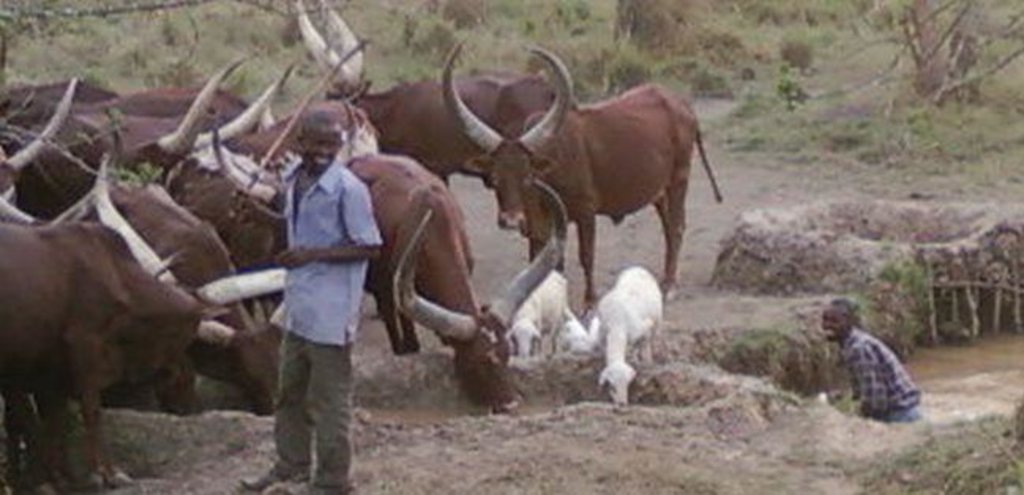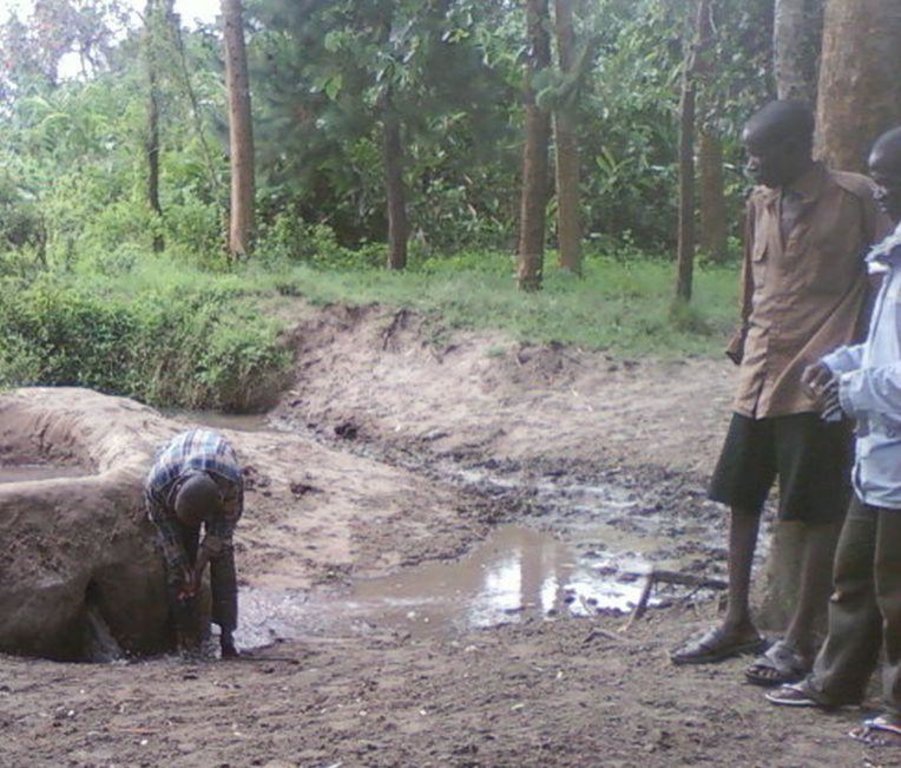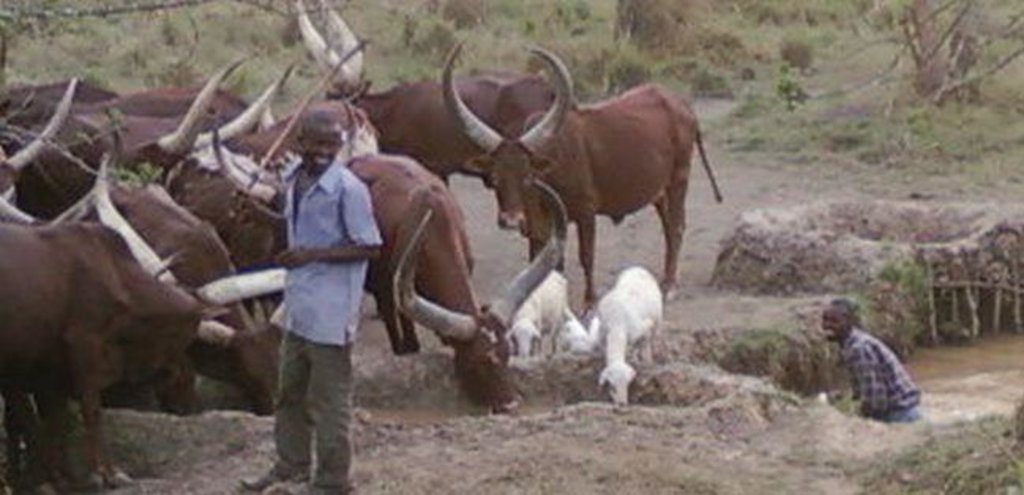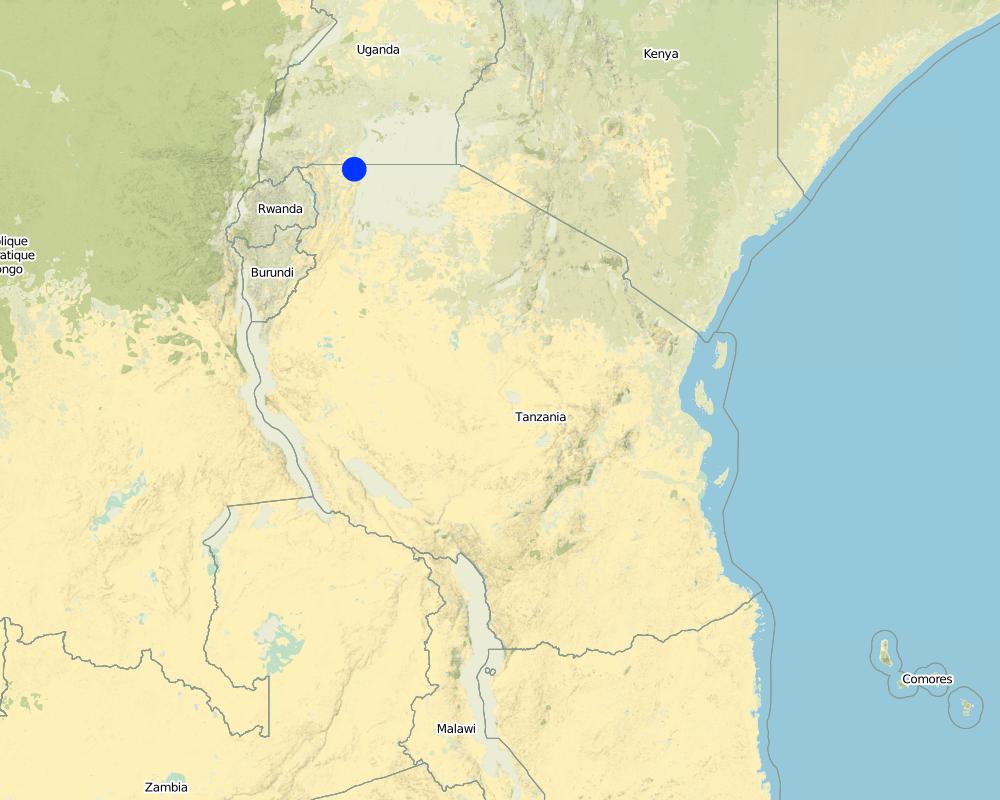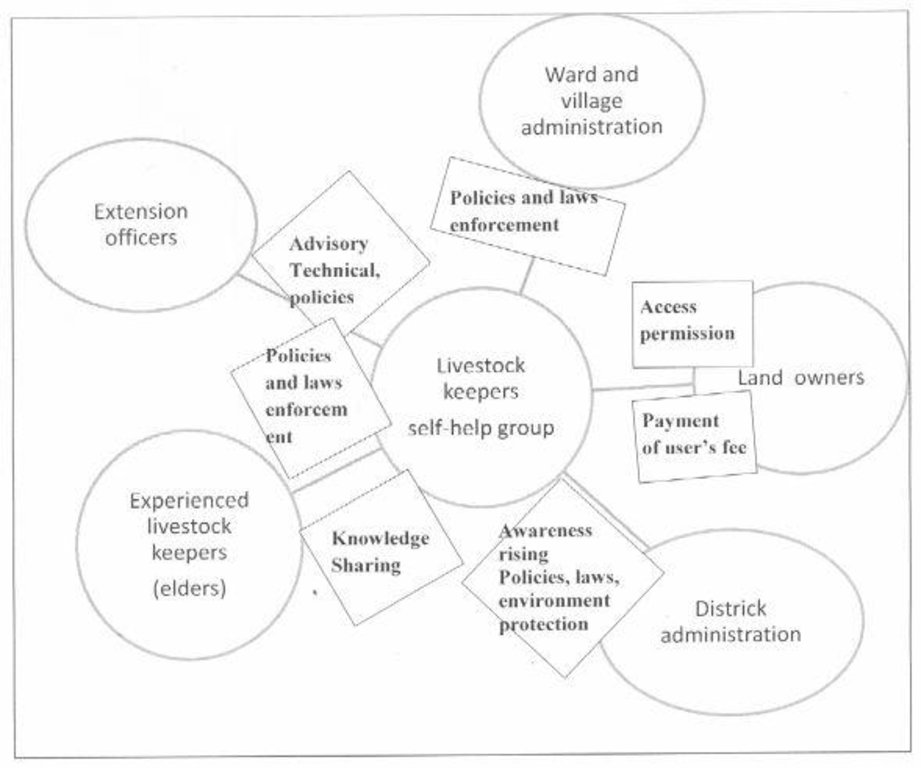Livestock keepers initiative for continued dry season animal drinking water supply [Tanzanie]
- Création :
- Mise à jour :
- Compilateur : ALLAN BUBELWA
- Rédacteur : –
- Examinateur : Fabian Ottiger
Emigilile ya abatungi b’ente oyokueshela ente
approaches_2589 - Tanzanie
Voir les sections
Développer tout Réduire tout1. Informations générales
1.2 Coordonnées des personnes-ressources et des institutions impliquées dans l'évaluation et la documentation de l'Approche
Spécialiste GDT:
Spécialiste GDT:
Spécialiste GDT:
Subira John
Missenyi district council
Tanzanie
Spécialiste GDT:
Kagaruki Annagrace
Missenyi district council
Tanzanie
Spécialiste GDT:
Kitundu Elizabeth
+255 0732983531,
missenyicouncil@yahoo.com
Missenyi District Council
Box 38 Kyaka Missenyi Kagera
Tanzanie
Spécialiste GDT:
Kaihura Fidelis
National Project Manager
Tanzanie
Nom du projet qui a facilité la documentation/ l'évaluation de l'Approche (si pertinent)
The Transboundary Agro-ecosystem Management Project for the Kagera River Basin (GEF-FAO / Kagera TAMP )Nom du ou des institutions qui ont facilité la documentation/ l'évaluation de l'Approche (si pertinent)
Food and Agriculture Organization of the United Nations (FAO) - ItalieNom du ou des institutions qui ont facilité la documentation/ l'évaluation de l'Approche (si pertinent)
Missenyi District Council (Missenyi District Council) - Tanzanie1.3 Conditions relatives à l'utilisation par WOCAT des données documentées
Quand les données ont-elles été compilées (sur le terrain)?
28/08/2012
Le compilateur et la(les) personne(s) ressource(s) acceptent les conditions relatives à l'utilisation par WOCAT des données documentées:
Oui
1.4 Références au(x) questionnaire(s) sur les Technologies de GDT
2. Description de l'Approche de GDT
2.1 Courte description de l'Approche
Livestock keepers groups and local government collaboration for management of livestock watering points.
2.2 Description détaillée de l'Approche
Description détaillée de l'Approche:
Aims / objectives: The main aim of this approach is to improve management of water resources through strengthening collaboration between land owners and livestock keepers for efficient livestock production/management and increased incomes. This approach ensures livestock watering point accessibility during dry seasons. Objective is to reach a compromise between livestock keepers and land owners on terms of conditions for access and use of watering points. As results livestock keepers and land owner can improve their planning activities and minimize conflict between them.
Methods: A self-help livestock keepers group is normally formed. It establishes regular and efficient cooperation among the livestock keepers and negotiations with land owners on water access issues. They make financial contributions to support the established self-help group. Through these contributions construction and maintenance of the ponds and troughs (the livestock watering system) is assured. Construction and maintenance is also done through voluntary work.
This traditional system was developed by elders and spread through learning by doing from the old to the young generation. In passing over knowledge from the elderly to the youths, experience in livestock and water resources management systems is gained.
The approach is also characterized by reverence to the existing village by-laws reinforced by the village government as well as existing customary laws to prevent degradation and pollution of water sources. Extension officers provide technical backstopping on recommended animal health practices that include deworming, routine spraying and vaccination against diseases.
Stages of implementation: Implementation takes place in three stages
1) Livestock keeper group formation: The group size is determined by the number of livestock. A single trough can accommodate not more than 150 cattle which determine the number of livestock keepers to form a group. The group has its informal organizational system with a nominated leader.
2) Contributions and voluntary works: Each livestock keeper makes a payment of about 20 dollars to the land owner as annual user fee. Maintenance is the responsibility of all livestock keepers.
3) Management: Include use of by-laws and provision of advisory services
Role of stakeholders: Land owner: He has the key role of ensuring that the area is used in a sustainable manner. Group members pay land rent to him for area utilization and management.
Livestock keepers: These are key users of the area, voluntarily participate in construction and maintenance of water troughs, pay land rent, manage and control watering of their animals.
Village and Ward administration and elders: Ensuring that village by-laws and customary laws guiding use of fragile ecosystems are adhered to.
Ward and village extension officers: Provide technical advisory to livestock keepers.
District administration and extension staff: Facilitating and enabling community understanding of policy, acts and laws guiding use of fragile ecosystems so that they can make informed management decision.
Other important information: This approach plays significant role in preventing conflict between domestic water users and livestock keepers especially during the dry season.
2.3 Photos de l'approche
2.5 Pays/ région/ lieux où l'Approche a été appliquée
Pays:
Tanzanie
Région/ Etat/ Province:
TANZANIA
Autres spécifications du lieu :
MISSENYI
Map
×2.7 Type d'Approche
- traditionnel/ autochtone
2.8 Principaux objectifs de l'Approche
The Approach focused mainly on SLM with other activities (Construction, managment and utilization)
Minimizing of land dagradation and better water availability to contribute to livelihood improvement.
The SLM Approach addressed the following problems: 1. There was no livestock keepers organization to comprise over use of water resource during the dry season.
2. Water use conflict between livestock keepers and domestic water users
3. Weak administration of bylaws.
2.9 Conditions favorisant ou entravant la mise en œuvre de la(des) Technologie(s) appliquée(s) sous l'Approche
normes et valeurs sociales/ culturelles/ religieuses
- entrave
Traditionally livestock keepers keep large herds for prestige.
Treatment through the SLM Approach: Livestock keeper with large herds are advised to reduce number of animals by selling extra animals and use funds for intensifying management and maximizing productivity.
disponibilité/ accès aux ressources et services financiers
- entrave
Livestock keepers are not aware of the services provided by financial institutions and are ignorant of the basic bookkeeping skills.
Treatment through the SLM Approach: Sensitized livestock keepers on utilization of financial institutions and provide training in the basic bookkeeping skills.
cadre institutionnel
- entrave
Livestock keepers informally organized but not legally recognized; the groups are not registered and have no written constitution.
Treatment through the SLM Approach: Livestock keeper advised to strengthen their groups/organization through registration by relevant authorities and establish a written group constitution.
cadre juridique (régime foncier, droits d'utilisation des terres et de l'eau)
- entrave
Ignorance of livestock keepers on the Act, Laws and Rules governing the use of fragile ecosystems.
Treatment through the SLM Approach: Extension workers enabling and facilitating community understanding of policy and acts guiding use of fragile ecosystems.
connaissances sur la GDT, accès aux supports techniques
- entrave
Low knowledge on recommended livestock rearing practises and water borne diseases.
Treatment through the SLM Approach: Training livestock keepers on recommended livestock rearing practices, prevention and controll of water borne diseases as well as water hygine and sanitation.
charge de travail, disponibilité de la main-d'œuvre
- entrave
High work load needed in filling of the water troughs
Treatment through the SLM Approach: Livestock keepers advised to use water pumping machines (simple and manually operated machines).
3. Participation et rôles des parties prenantes impliquées dans l'Approche
3.1 Parties prenantes impliquées dans l'Approche et rôles
- exploitants locaux des terres / communautés locales
Key implementer and user of the SLM approach, the land owner and the livestock keepers
Traditionally grazing stocks (cattle, sheep and goats) are owned and reared by men and therefore the approach mainly involves men. The roles area largely men specific.The approach also targeted low income livestock owners (casual cattle herds man).
- Spécialistes de la GDT/ conseillers agricoles
District, ward and village extension officers
- gouvernement local
Provision of technical advisory services, policy and act interpretation and reinforcement of village bylaws.
- gouvernement national (planificateurs, décideurs)
Village and Ward elected and employed representatives.
3.2 Participation des exploitants locaux des terres/ communautés locales aux différentes phases de l'Approche
| Participation des exploitants locaux des terres/ communautés locales | Spécifiez qui était impliqué et décrivez les activités | |
|---|---|---|
| initiation/ motivation | auto-mobilisation | Livestock keepers /elders: Inheritance and transference of the approach to youth. |
| planification | auto-mobilisation | Livestock keepers /elders: Informal planning and improvement through cycles of action and reflection. |
| mise en œuvre | auto-mobilisation | Livestock keepers individuals and groups, village leaders and agricultural advisers: use of the approach, law enforcement and technical advisory services and interpretation of act, law and guidelines protecting fragile ecosystems. |
| suivi/ évaluation | auto-mobilisation | Livestock keepers individuals and groups, village leaders and agricultural advisers and SLM specialists: manage effective use of the technology, ensure adherence of Acts, Rules and Regulation and SLM documentation for dissemination and sharing. |
| Research | interactive | Livestock keepers individuals and groups and agricultural advisers and SLM specialists: identification and documentation of researchable issues. |
3.3 Diagramme/ organigramme (si disponible)
Description:
Livestock keepers initiative for continued dry season animal drinking water supply.
Auteur:
Allan Bubelwa (Box 38 Kyaka, Missenyi, Kagera, United Tanzania)
3.4 Prises de décision pour la sélection de la Technologie/ des Technologies
Indiquez qui a décidé de la sélection de la Technologie/ des Technologies à mettre en œuvre:
- les exploitants des terres seuls (auto-initiative)
Expliquez:
A decision to use the technology relies on livestock keepers self-mobilization, own choice induced through inheritance and learning by doing.
Decisions on the method of implementing the SLM Technology were made by by land users* alone (self-initiative / bottom-up). Decision to use the method is partly through spontaneous adoption from elders and improvement through cycles of action and reflection.
4. Soutien technique, renforcement des capacités et gestion des connaissances
4.1 Renforcement des capacités/ formation
Une formation a-t-elle été dispensée aux exploitants des terres/ autres parties prenantes?
Oui
Spécifiez qui a été formé:
- exploitants des terres
- personnels/ conseillers de terrain
- village and ward leaders
Si pertinent, spécifiez le genre, l'âge, le statut, l'ethnie, etc.
both men and women and all ages (youth and elders).
Formats de la formation:
- sur le tas
- réunions publiques
Formats de la formation:
- seminar and workshops.
Thèmes abordés:
Act and Laws guiding the use of fragile ecosystems, prevention of water borne diseases, recommended livestock keeping methods and water management.
4.2 Service de conseils
Les exploitants des terres ont-ils accès à un service de conseils?
Oui
Spécifiez si le service de conseils est fourni:
- dans les champs des exploitants?
Décrivez/ commentez:
Name of method used for advisory service: Farmer field school ; Key elements: learning by doing on the job and in the field (Number of knowledge sharing activities: on the job training, field practice), adult learning – livestock self-help groups , livestock management. , indegenous and technical knowledge balanced and combined in a complementary manner.; Technical advisory services largely involved building on and improving the successful experience resulted from the use of indigenous knowledge.
Advisory service is quite adequate to ensure the continuation of land conservation activities; The increase number of extension workers from 1 to 2 and introduction of TAMP project (trans boundary agro-ecosystem management project) in the village will speed up implementation of conservation activities in the village.
4.3 Renforcement des institutions (développement organisationnel)
Des institutions ont elles été mises en place ou renforcées par le biais de l'Approche?
- non
4.4 Suivi et évaluation
Le suivi et l'évaluation font ils partie de l'Approche? :
Oui
Commentaires:
bio-physical aspects were ad hoc monitored by government, land users through observations; indicators: extent of area eroded
bio-physical aspects were ad hoc monitored by government, land users through measurements; indicators: Ponds/troughs and maintenance requirements
technical aspects were ad hoc monitored by land users through observations; indicators: number of livestock keeper trained
technical aspects were ad hoc monitored by land users through measurements; indicators: number of conflicts between land owners and livestock keepers
socio-cultural aspects were ad hoc monitored by land users through observations; indicators: number of water conflict emerged and number resolved
socio-cultural aspects were ad hoc monitored by government, land users through measurements; indicators: livestock production and productivity
economic / production aspects were regular monitored by government through observations; indicators: increase in milk and meat productivity
economic / production aspects were regular monitored by government, land users through measurements; indicators: livestock keepers using the technology
no. of land users involved aspects were regular monitored by government, land users through observations; indicators: number of livestock keepers using the technology
no. of land users involved aspects were regular monitored by government, land users through measurements; indicators: adherence to water protective bylaws
management of Approach aspects were regular monitored by government through observations; indicators: % number of village bylaws used and adhered to
management of Approach aspects were regular monitored by government through measurements; indicators: None
There were few changes in the Approach as a result of monitoring and evaluation: Implementation of group roles and adherence to by-laws e.g. protection of natural vegetation.
There were few changes in the Technology as a result of monitoring and evaluation: decrease in destruction of natural vegetation and reduction of eutrophication at the water source.
4.5 Recherche
La recherche a-t-elle fait partie intégrante de l’Approche?
Oui
- adaptive SLM trials
Donnez plus de détails et indiquez qui a mené ces recherches:
Adaptive trials through SLM demos by TAMP, ARI MARUKU and community. Farmers select the best bets technologies to apply on their own fields.
Research was carried out on-farm
5. Financement et soutien matériel externe
5.1 Budget annuel de la composante GDT de l'Approche
Si le budget annuel précis n'est pas connu, indiquez une fourchette:
- < 2 000
Commentez (par ex. principales sources de financement/ principaux bailleurs de fonds):
Approach costs were met by the following donors: local government (district, county, municipality, village etc) (animal related extesion services, policy and law enforcement.): 20.0%; local community / land user(s) (voluntary contribution by livestock keeper groups and land owner ): 80.0%
5.2 Soutiens financiers/ matériels fournis aux exploitants des terres
Les exploitants des terres ont-ils reçu un soutien financier/ matériel pour la mise en œuvre de la Technologie/ des Technologies?
Non
5.3 Subventions pour des intrants spécifiques (incluant la main d'œuvre)
Si la main d'œuvre fournie par les exploitants des terres était un intrant substantiel, elle était:
- volontaire
Commentaires:
labour is needed in taking the animals for watering as well as during actual watering of the animals.
5.4 Crédits
Des crédits ont-ils été alloués à travers l'Approche pour les activités de GDT?
Non
6. Analyses d'impact et conclusions
6.1 Impacts de l'Approche
Est-ce que l'Approche a aidé les exploitants des terres à mettre en œuvre et entretenir les Technologies de GDT?
- Non
- Oui, un peu
- Oui, modérément
- Oui, beaucoup
This approach plays significant role in reducing conflict between domestic water users, increased availability of water and conservation of water resources.
Est-ce que l'Approche a autonomisé les groupes socialement et économiquement défavorisés?
- Non
- Oui, un peu
- Oui, modérément
- Oui, beaucoup
The approach enables low income-cattle herd man to earn income.
Did other land users / projects adopt the Approach?
- Non
- Oui, un peu
- Oui, modérément
- Oui, beaucoup
other livestock group adopted the approach (in dry season).
Did the Approach lead to improved livelihoods / human well-being?
- Non
- Oui, un peu
- Oui, modérément
- Oui, beaucoup
Livestock keepers that joined self-help groups improved livestock productivity and increased income
Did the Approach help to alleviate poverty?
- Non
- Oui, un peu
- Oui, modérément
- Oui, beaucoup
year round availability of water for animals, increased animal production and productivity and income to livestock keepers and improve rural socio-economic conditions.
6.2 Principale motivation des exploitants des terres pour mettre en œuvre la GDT
- augmenter la production
improved animals heath and increased production
- règles et règlements (amendes)/ application
rules preventing livestock keepers from watering their animals in domestic water sources
- conscience environnementale
developed through various SLM trainings provided by extension officers.
6.3 Durabilité des activités de l'Approche
Les exploitants des terres peuvent-ils poursuivre ce qui a été mis en œuvre par le biais de l'Approche (sans soutien extérieur)?
- incertain
Si non ou incertain, spécifiez et commentez:
in the future a support is needed in terms of group management and organizational development, marketing and business planning skills and livestock keepers also need further exposure to SLM concept.
6.4 Points forts/ avantages de l'Approche
| Points forts/ avantages/ possibilités du point de vue de l'exploitant des terres |
|---|
| Is a mechanism for assurance of water availability for animal watering in the dry season. (How to sustain/ enhance this strength: continue with good collaboration with the land owner and livestock keeper solidarity.) |
| Points forts/ avantages/ possibilités du point de vue du compilateur ou d'une autre personne ressource clé |
|---|
| The training of extension officers, elders etc covered many aspects of sustainable livestock production and natural water resources protection (How to sustain/ enhance this strength: Activities presented during the training should be put into practice and spread among other livestock keepers ) |
| Involvement of the district administration, wards, elders in the approaches implementation (How to sustain/ enhance this strength: insist on active involvement ) |
| Strong commitment of livestock keepers to improve livestock production and their livelihood (How to sustain/ enhance this strength: Awareness raising ) |
| Reduced conflict between water for domestic use and for watering animals (How to sustain/ enhance this strength: strengthen use of the approach and bylaws guiding it ) |
| Reduced cost and largely relies on self mobilization and voluntarism of the livestock keepers. (How to sustain/ enhance this strength: Group management and organizational development to strengthen cohesiveness.) |
| Is dynamic, flexible and accommodate outside advisory and technical support and therefore opens opportunities for future improvement. (How to sustain/ enhance this strength: Needs assessment and provision of appropriate advisory and technical support. ) |
6.5 Faiblesses/ inconvénients de l'Approche et moyens de les surmonter
| Faiblesses/ inconvénients/ risques du point de vue de l’exploitant des terres | Comment peuvent-ils être surmontés? |
|---|---|
| low know how | broadern know how |
| Faiblesses/ inconvénients/ risques du point de vue du compilateur ou d'une autre personne ressource clé | Comment peuvent-ils être surmontés? |
|---|---|
| The approach is largely informal in terms of livestock keepers organization. There is no written constitution and the groups are not registration. | improvement in terms of formulation of group constitution, opening of bank account and group registration. |
| Narrow focus largely relies solely on indigenous knowledge base . | broaden horizon of understanding by combining with technical knowledge base. |
| Lack of promotion materials to involve other livestock keepers | increase number of promotion materials |
| Rural poverty not reduced significantly | more activities that can lead to reduction of rural poverty required |
7. Références et liens
7.1 Méthodes/ sources d'information
- visites de terrain, enquêtes sur le terrain
- interviews/entretiens avec les exploitants des terres
7.2 Références des publications disponibles
Titre, auteur, année, ISBN:
Kagera TAMP project (pdfFinal Report 2013)
Disponible à partir d'où? Coût?
http://www.fao.org/fileadmin/user_upload/oed/docs/GCPRAF424GFF_2013_ER.pdf
Liens et modules
Développer tout Réduire toutLiens
Aucun lien
Modules
Aucun module trouvé



